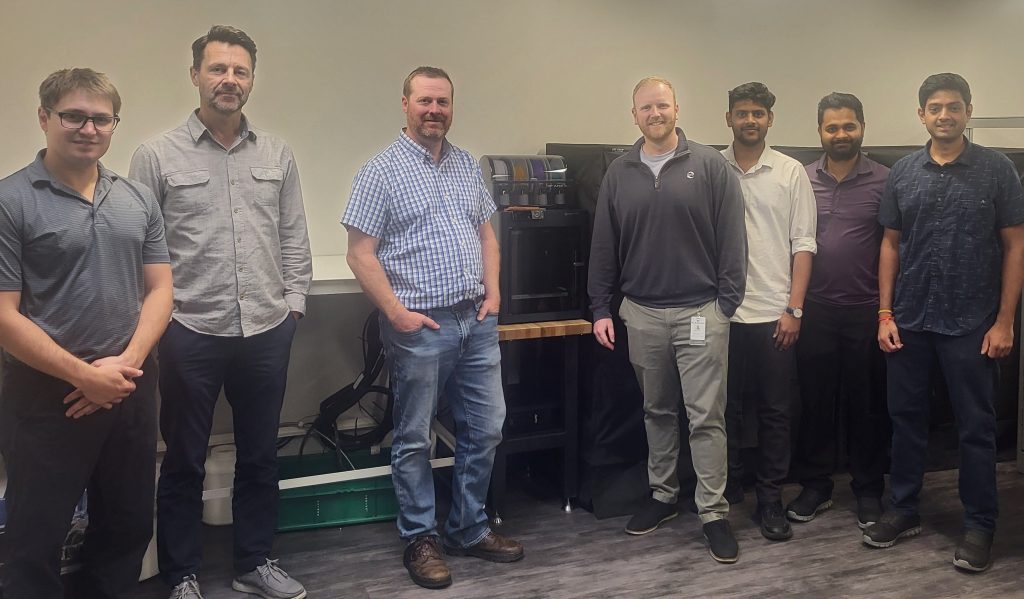The faint whir of the 3D printer is a new sound in the normally hushed corner of the Product Development Engineering (PDE) team’s office area at Windsor 3 Manufacturing. Over the years, the PDE group have worked in their own separate cubicles, their work moving through a deliberate pipeline of digital design, external prototyping, and endless email chains. But as the business changes and we evolve there is always room for improvements and finding ways to be more efficient.
A simple solution: a central collaboration hub. The team cleared out a corner of the office, brought in a workbench, toolbox, a touchscreen TV, and, most importantly, a state-of-the-art 3D printer.
The 3D printer has allowed the team to quickly and easily print model of parts that are under development, fostering many collaborative conversations and investigations with other departments in Plasman. The Paint and Assembly departments benefit most from having physical samples to review, allowing the PDEs to incorporate the feedback from those departments before a mold is cut.
“The collaboration area allows us to take a more hands-on approach to problem solving and testing,” said Matt Miller, Manager, Product Engineering, Windsor 3 Manufacturing, Plasman. “It provides a dedicated space for discussion and enables impromptu meetings that don’t tie up conference rooms or interrupt desk neighbors. I think the fact that the PDEs built the area themselves gives them a greater sense of ownership over it.”
Recently, the PDEs were approached by an OEM with a question about the purpose of some tabs that were added to a Spoiler doghouse, a feature that connects a part to a mating surface and typically provides an attachment point for a fastener. The team was able to 3D print the concept within a day and create a video illustrating the intended function of the tabs to show the OEM. This allowed the team to communicate the function more effectively than a PowerPoint with diagrams and arrows that in some cases would need to be translated.
The collaboration area isn’t just a physical space; it is a catalyst for change. Designers, engineers, and analysts can find themselves talking to each other more, sharing ideas spontaneously, and resolving issues in real time. The 3D printer is the centerpiece of their workflow. A quick prototype of a CHMSL harness, custom tabs for a spoiler, a new design for a fascia—all of these ideas can now be brought to life, tested, and refined in a matter of days, not weeks.
“Our printer has run nearly non-stop since getting it in June,” said Miller. “We can print parts as needed at much lower cost than outsourcing them. In addition to parts, we’ve printed measurement aids, nests to mock-up assembly equipment changes, and more. It’s been a very good investment.”
The most significant change isn’t the speed, but the quality of work. Overall, the area and the tools in it have made the Produce Development Engineering team self sufficient for a number of tasks that used to require space or assistance from other departments and thereby tied up their resources. The 3D printer is more than just a tool; it’s the engine that powers a new way of working, transforming a fragmented team into a cohesive, highly efficient unit as one team.

Chris Foster, Zeljko Mitrovic, Matt Miller, Brad Roy, Saurabh Shah, Nisharg Chauhan, Sai Jonnalagadda
About Plasman
Plasman is a leading global manufacturer in bumpers-fascias, grilles, exterior trim, and subsystem components. As One Driving Force™, our diverse team of talented employees in 10 countries is driven by a commitment to outperform in all areas from engineering design to state-of-the-art manufacturing processes. Plasman’s headquarters are in Oldcastle, Ontario. Further information about Plasman is available at Plasman.com or follow us on LinkedIn.
